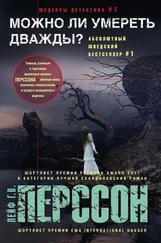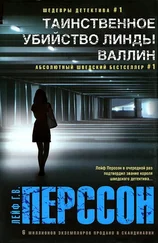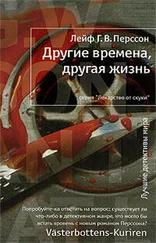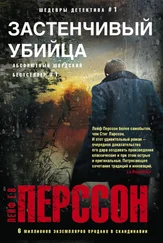“Thanks,” said Wiijnbladh, smiling wanly. “Thanks.”
Eriksson had died of a knife wound or rather a knife thrust that had been administered at an angle from above.
It had struck him from behind, high up on his back, between the left shoulder blade and spine and passed between two ribs into the chest cavity, wounding the heart, left lung, and the aorta. The stabbing resulted in rapid, extensive loss of blood, dramatic drop in blood pressure; the victim lost consciousness and stopped breathing, which led to death within a few minutes at most. The knife blade had been held at an inclined horizontal angle when the knife struck the body, which thus argued for a thrust rather than a cut; a cut would have produced an incision that was vertical or inclined to vertical as a rule.
The weapon was a large, very sharp, single-edged knife with a straight blade at least ten inches in length and two inches wide where the end of the blade met the handle. These observations in connection with the autopsy matched the knife in the photo that Wiijnbladh had faxed over to her before he came. And as for that, by the way, there was something she wanted to say.
“I understand that the intention was good,” said Birgit, fastening her eyes on Wiijnbladh, “but in future I want you to wait with this type of information until I ask for it. First, I want to form my own opinion. I’m a forensic physician, not a fortune-teller.”
“Of course, of course,” said Wiijnbladh.
“Was there anything else?” asked Birgit, inspecting him up and down.
“The time,” said Wiijnbladh. “Can you say anything about the time?”
“When you got the alarm. Around eight o’clock. Nothing I’ve seen contradicts that time. I thought it was you who wrote the fax I received? At least your name was on it.” Birgit shrugged her shoulders.
“I’ve been thinking about something,” Wiijnbladh said carefully. “Eriksson was five foot ten inches tall, and in my mind I see a perpetrator who must be considerably taller than Eriksson, and have considerable body strength besides. Considering the angle of incision and the depth of the cut, that is,” Wiijnbladh clarified. Surely she must be able to take all that in. She has an academic degree, after all, he thought.
Now she looked pleased in a manner that Wiijnbladh experienced as deeply disturbing.
“So that’s what you see in your mind,” said Birgit.
“Yes,” said Wiijnbladh. “A big, powerful perpetrator, very tall, about six foot three, considerable body strength, violent stab... or else a thrust then... so to speak.”
“I see,” said Birgit tranquilly, inspecting her neat, short trimmed nails. “Personally I might imagine that Eriksson was sitting on that couch I saw in one of your pictures. As far as the stab wound is concerned, no particular strength would be required for that. A sharp knife slipped in between two ribs. The perpetrator sneaks up behind and just makes a thrust. If it had been me who’d done it I would have been very surprised at the result.”
“Could it have been a professional of some type?” said Wiijnbladh. “Considering where the stab went in, I mean. In my opinion this suggests considerable anatomical knowledge.”
“Where do you get all this from?” asked Birgit, sighing. “Is this the sort of nonsense that you and your colleagues sit and blabber about with Milan? It was pure luck, or bad luck depending on how you look at it. Call it what you want. How could the perpetrator see where the victim’s ribs were? The poor man had his shirt on. Unless you think that the perpetrator came up and squeezed his chest cavity before he stabbed him?”
“No, that’s clear,” said Wiijnbladh. What a horrid person, Wiijnbladh thought, and to top it off he had started to sweat too.
“Was there anything else?” said Birgit, nodding courteously at the clock on the wall of her office. “Otherwise I actually have a lot to do.”
Good Lord, thought Wiijnbladh. Bäckström’s question.
First he felt almost desperate, but then he breathed deeply, pulled himself together, and asked it, because it had to be done anyway, even if he gladly would have switched places with that fat runt from the homicide squad.
“Just one more thing,” said Wiijnbladh. “I was wondering... during your autopsy here... did you make any observations that suggest that Eriksson... the victim, that is.... that he was... well, homosexual? So to speak.”
“You mean whether he had a tail,” said Birgit, looking at Wiijnbladh with an amused smile.
“No,” said Wiijnbladh, smiling nervously. “Perhaps you understand what I mean?”
“No, actually not,” said Birgit. “I can only guess. You’re wondering if I found anything that indicated that he, for example, was regularly penetrated in the rectum in connection with anal intercourse.”
“Just so,” said Wiijnbladh. “For example, anally, so to speak.”
“Or if I found semen in his rectum or made any other terrifying observations regarding his penis?”
“Yes,” said Wiijnbladh, and now he felt the sweat running down between his skinny shoulders. “Did you?”
“No,” said Birgit. “So you and the other boys up there on Kungsholmen can be completely at ease.”
“Well, okay then, then I’ll just say thanks,” said Wiijnbladh.
“It was nothing,” said Birgit.
After their visit to the Central Bureau of Statistics, Jarnebring and Holt went to the SACO union headquarters in Östermalm. When they inquired about Eriksson’s doings, Eriksson’s boss answered that the day before, the same day he was murdered, Eriksson was supposed to attend a conference on current issues in labor law hosted by SACO. This also proved to be true.
“He was invited as a representative of the academics employed at Statistics who are organized within TCO,” the woman who took care of the practical details in connection with the conference confirmed.
Then she retrieved the conference program and the list of participants. It was a one-day conference that began at nine o’clock in the morning and concluded at five with a break for lunch between twelve and one. It had been held in the SACO offices and had featured current issues in labor law as stated, which was always interesting to the union and its members. There had been fifty-some participants besides Eriksson.
“And you’re quite sure that Eriksson was at the conference?” Jarnebring asked.
He had registered in the morning and received his conference materials. Of that she was quite certain because she had taken care of that detail herself and she recognized Eriksson from previous, similar meetings. On the other hand she was uncertain if he had been there the whole day.
“It’s not unusual for people to come and go,” she explained, and personally she’d had other things to think about than Eriksson’s presence, even if naturally she didn’t put it that way.
With the help of her two coworkers the details were soon cleared up.
Eriksson had been at the conference until lunch. He should have stayed the whole day, but at the short smoking break before the last lecture before lunch he had excused himself and reported that something had come up at work and he was going to have to depart at twelve, which meant he wouldn’t have time for lunch.
“Did you get the impression that something had happened? Did he seem upset or anything?” Holt asked the conference hostess with whom Eriksson had spoken.
Nothing strange at all, as far as she could recall. He had been happy and pleasant, almost exuberant, and because people basically came and went the whole time, it wasn’t strange that Eriksson too had departed, was it? She’d made a note to inform the kitchen that there would be one person less for lunch. That was it.
Читать дальше












